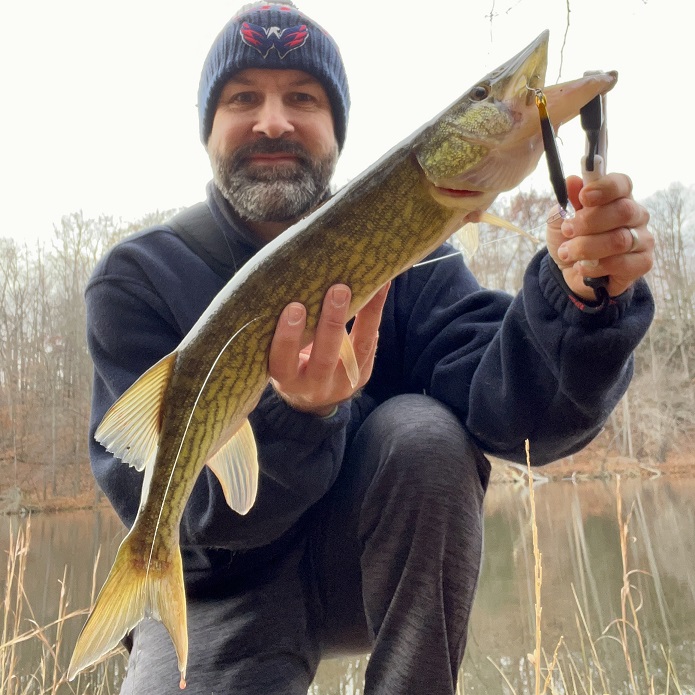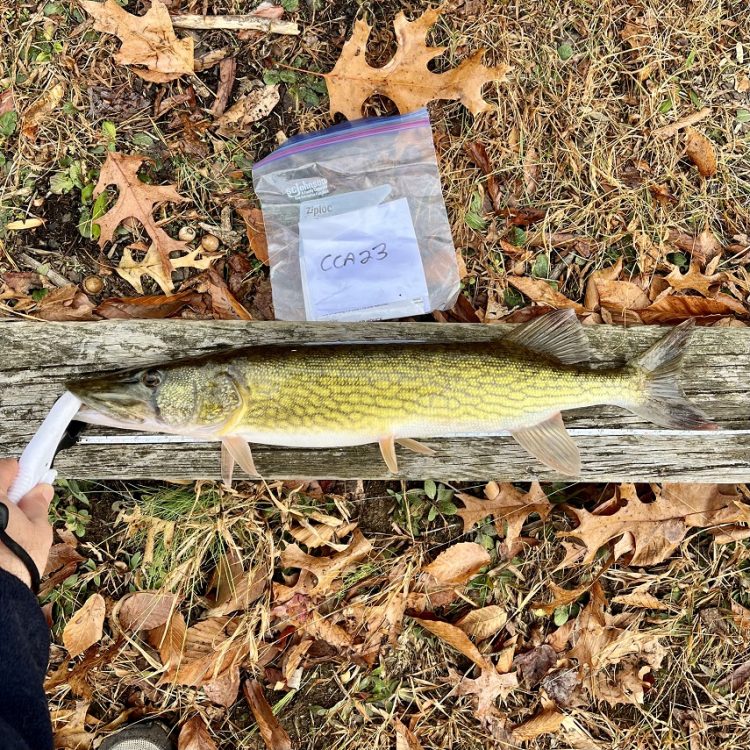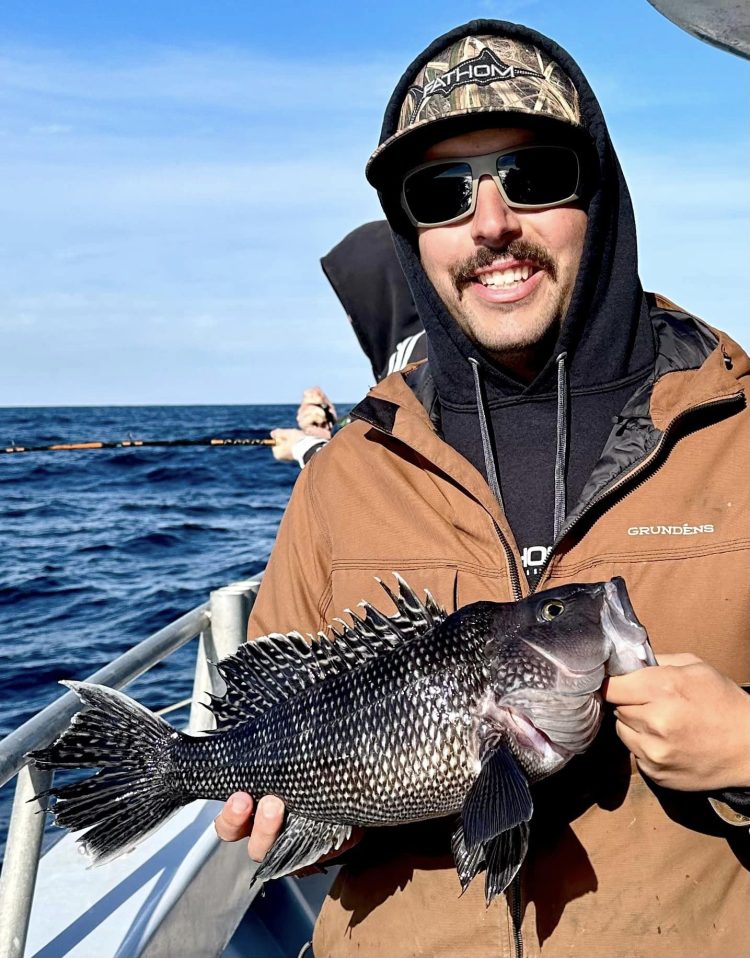Maryland & Chesapeake Bay Fishing Report- December 7, 2023
Deep-dwelling sea bass and porgies bite for bottom fishermen, stripers chase bait beneath birds in the middle Bay, and pickerel and catfish are active in the rivers.
Maryland & Chesapeake Bay Fishing Report
Reel Chesapeake Fishing Report – Annapolis, MD
The Reel Chesapeake Fishing Report is written and compiled by writer and media professional, James Houck. Find the full report here, at reelchesapeake.com.
Very active week in middle Chesapeake Bay waters. Though a couple days of heavy fog made for dicey-but-doable fishing trips, the weather has been mostly stable with cold overnight temperatures in the 30s Fahrenheit and daytime temps reaching upwards of 45. The water has cooled down into the mid-40s. Anglers have taken advantage of these conditions. Winds persist but are manageable with Thursday, Friday, and Saturday looking favorable to get on the water.
Sunday will see a frontal system move into the region with gales. Small craft advisories will likely be in effect early next week. On Tuesday, the waning moon becomes new and the tidal currents will be relatively strong later into the week, with the most movement occurring afternoons into early evening.
The charter fishing fleet has been finding an excellent grade of striped bass in the middle Bay. A 15- to 20-minute ride from marinas and ramps on either side of the Bay (Annapolis or Kent Island) into the main stem has put anglers on schools of bass; sometimes large and working deep under masses of feeding birds. Other times, wolf packs roaming a bit deeper. Depth transitions and ambush points along the shipping channel, from the mouth of the Patapsco River southward to the Potomac River, are alive with fish.
It’s an expansive area, but with fish feeding heavily on the bunker, you should be able to find them on your electronics. Target areas include river mouths and their junction with deep water, especially major points such as Love, Sandy, Hackett, Tolley, Thomas, Bloody, Cove, and Cedar. Also the lower-80 channel buoys and those marking the deeper water at the Choptank River mouth.
With the colder water temperatures, fish will be closer to bottom, so jigging lead heads with plastics, large flutter spoons, or rain minnow style jigs to get down deep is key—anything 1 to 3 ounces should get to the fish. Trolling heavy umbrella or tandem rigs is also popular, but with only a couple days left of keeper-season, expect trolling traffic on the Bay to curtail significantly.
After December 10th, striped bass fishing becomes a catch-and-release affair until next summer. And that’s okay because the light tackle game for stripers moving back into the Bay from the Atlantic migration should be excellent this winter.
Some Bay anglers are also targeting the new black sea bass fishery that seems to have developed this season in the middle Chesapeake. Bottom rigs baited with Fishbites has been a preferred tactic we’re seeing. The fish have been hugging structure (Bay Bridge pilings) or reef sites. The same can be said for white perch, as the species continues to congregate for wintering in deep water.
Chain pickerel are on many anglers’ minds, myself included. Kayak and small craft folks that can’t access the larger Bay for stripers are having a ball in the region’s rivers, small creeks, and impoundments targeting these feisty fish. Light to medium tackle and a variety of lures can catch the aggressive pickerel. Right now, with the water temps in the 40s, jerkbaits worked slowly with pauses upwards of five seconds can be deadly. As the water gets a bit colder, work them even slower (10 second pauses). And if you get a pickerel to chase your lure to the boat but not commit, try changing it up and casting something different right away to the same fish. An inline spinner or small jig/plastic perhaps. The best waters for pickerel include the Severn, Magothy, and Patapsco rivers, and the Eastern Shore millponds.


Yellow perch are increasingly in the mix—same waters, but also in the upper Tuckahoe, Marshyhope, and Patuxent systems. Small micropaddletails or stingers on 1/16 to 1/8-ounce jigs, or beetlespins should get bites. Try the back ends of creeks or around any grassbeds. You may also find crappie in the mix, especially around laydowns with crowns in water deeper than 6 feet.
I think we’ll also see an uptick in blue catfish reports as more and more anglers turn on to them. There’s been excellent fishing this week for the invasive species in the Potomac River, from D.C. south; in the Patuxent River, from Jug Bay south; and the Nanticoke River system on the shore. Try fish finder rigs weighted appropriately for the depths and currents you’re fishing (it could take anywhere from 1-ounce to 10!), and baited with the freshest chunk you can get your hands on. Good luck!
View the full Reel Chesapeake Fishing Report, written and compiled by writer and media professional James Houck, at reelchesapeake.com.
Angler’s Sport Center Fishing Report – Annapolis, MD
The Angler’s Sport Center fishing report is compiled and written by Anglers Team Member, A.J. Lewis.
Upper and Middle Bay
The Susquehanna River has become a prime destination for blue catfish enthusiasts. Known for their impressive fights, these invasive fish not only provide an exhilarating angling experience but also offer an abundance of delicious meat for those looking to stock their freezers. The combination of a thrilling catch and a rewarding culinary outcome makes blue catfishing in the Susquehanna River a standout experience for avid anglers! As water temperatures continue to cool down, blue catfish in the area are becoming more active, leading to increased success for anglers. Various lures and baits are proving effective, with the favorite choices being cut soft crab or cut bunker.
The white perch in the tidal rivers of the upper and middle Bay have transitioned to deeper, warmer waters. Anglers targeting these fish at the bottom of deeper channels are finding success using bottom rigs, particularly the Chesapeake Sabiki Rig tipped with live or artificial bait such as FishBites or bloodworms. White perch tend to school up in these areas, offering anglers the opportunity for steady, reliable action. If you hook one, chances are you’ll be in for a productive day on the water!
Late fall and early winter brings about prime pickerel fishing conditions, with the cooling water temperatures activating these predatory fish. Chain pickerel, known for their ambush tactics, lurk around structures and shallow grass, patiently waiting to ambush unsuspecting prey. To capitalize on this behavior, anglers are finding success with paddletail swimbaits that exhibit lots of action. The lively movement of the swimbait proves enticing to pickerel, making it a top choice for a successful late fall and early winter fishing experience.
As the fall progresses, anglers are observing a decline in striped bass activity as these fish migrate south to seek warmer water temperatures. While they are becoming more scarce each day, anglers are still finding success by targeting them in deeper waters, particularly around channels. A variety of tactics, including jigging and trolling, are being employed. Anglers are having success with umbrella or tandem rigs, strategically deployed around the mouths of major tidal rivers. Stripers are being hooked at varying depths, ranging from 30 to 60 feet, providing anglers with numerous opportunities and locations for a rewarding catch.
South Bay
As white perch migrate out of tidal rivers, anglers are discovering schools congregating in deeper waters, particularly in the steep channels outside of the Patuxent and Potomac. The preferred method for targeting these fish in their new habitat is using bottom rigs. Anglers are finding success with this approach, offering an effective way to connect with white perch in deeper waters. As the seasons change, adjusting techniques to follow the movements of the fish ensures a continued and rewarding angling experience.
Anglers are shifting their focus to target catfish, particularly blue cats, as water temperatures cool and other fish migrate. This resilient species serve as an excellent alternative when other fishing opportunities slow down. The invasive nature of blue catfish means there’s no creel limit, offering ample chances to fill your freezer with their abundant and delicious meat. Successful anglers are employing cut bait, such as soft crab or cut bunker, to entice bites. Key areas like the mouth of the Potomac, the Nanticoke River, and Jug Bay are proving to be hotspots for these plentiful catfish. Get ready for some exciting blue catfish action in these prime locations.
Exciting news from the lower Potomac River area! Anglers are experiencing greater-than-usual success in landing striped bass. The key to their success lies in spotting birds chasing migrating baitfish, a clear sign that striped bass are in pursuit as well. Jigging beneath these flocks of birds has proven an effective technique for striped bass anglers. For those preferring trolling, the most effective techniques currently involve using either an umbrella rig or a tandem rig in water depths ranging from 30 to 60 feet. However, a friendly reminder to fellow anglers: when trolling around birds, be cautious not to disrupt the area by trolling through the school of bait. This consideration ensures a positive fishing experience for everyone trying to get in on the action.
The Angler’s Sport Center fishing report is compiled and written by Anglers Team Member, A.J. Lewis.
Sailing out of West Ocean City, Captain Monty Hawkins of Morning Star Fishing Charters is still out there getting boat limits of black sea bass on the offshore wrecks. On Monday the 4th, the skipper’s group of anglers battled high north winds and lots of weeds in the first half of the day, but the fishing picked up when the gusts died down below 10 knots. The whole boat proceeded to get their limit of sea bass, with some big porgies in the mix. Baited high-low rigs and heavy jigs were getting the job done.

Maryland DNR Fishing Report
Maryland DNR Fishing Report is written and compiled by Keith Lockwood, fisheries biologist with the Maryland Department of Natural Resources.
Freshwater
Fishing for smallmouth bass and walleye has been good – cooler water temperatures always get these two fisheries going and they should last through much of the winter. Deep Creek Lake, Prettyboy Reservoir, and the upper Potomac and lower Susquehanna rivers are excellent places to fish for smallmouth bass. Deep Creek Lake, the upper Potomac and the lower Susquehanna hold good populations of walleye. Most anglers like to use root beer-colored tubes and a mix of soft plastic swimbaits, and crankbaits for smallmouth bass; and soft plastic jigs, swimbaits, jerkbaits, and small crankbaits for walleye.
Trout fishing in many of the specialized trout management waters is very good this week for those who enjoy catch-and-release and fly fishing. The preseason stocking of trout will begin soon, so trout anglers should start checking the DNR trout stocking website.
Fishing for crappie is good this week, and they can be found schooled up near deep structure. Sunken brush, bridge piers, marina docks, and fallen treetops all fit the bill. Slowly working a small minnow or marabou jig under a slip bobber near the structure usually works well.
The cold winter months and fishing for chain pickerel go hand-in-hand. Anglers are having fun targeting the fish along shoreline sunken wood or deeper wood such as tree stumps in flooded reservoirs. The upper sections of the Bay’s tidal rivers is a great place to find chain pickerel, often near docks, pilings and fallen trees.
Anglers fishing with small minnows and Beetle-Spins will start to encounter yellow perch in the middle to upper sections of the Bay’s tidal rivers and creek. The fish tend to wander farther up the waterways when water temperatures are as cool as they are. When water temperatures dip below 40 degrees they will travel down river to deep holes and channels where they will hold until warming spring temperatures bring on the urge to head upriver to spawn.
Atlantic Ocean and Coastal Bays
The southward migration of large striped bass has finally entered Maryland waters this week, but a large portion of these fish will unfortunately be moving through waters beyond the 3-mile mark off Maryland’s shores and into the U.S. Exclusive Economic Zone. Most of these fish will also far exceed the maximum legal length of 31 inches to keep one. Some of these fish will surely pass along the beaches and ardent surfcasters will enjoy the action.
At the Ocean City Inlet there is no shortage of striped bass for anglers to enjoy. Most of the striped bass being caught fall short of the 28-inch minimum but provide plenty of fun catch-and-release fishing. Casting soft plastic jigs and paddletails is the most popular way to target them. They can also be found near the Route 90 and Verrazano bridges.
Each day more and more tautog are being caught in the inlet and Route 50 Bridge area and many are exceeding the 16-inch minimum, making anglers very happy. Pieces of green crab or sand fleas are the most popular baits.
The boats taking anglers to the offshore wreck and reef sites are finding limit catches of black sea bass for their anglers onboard. Other charters are now targeting tautog and some impressive catches are being reported.
Bluefin tuna are moving through our area, usually within the 30-Fathom curve and as close as 5 miles or so. Most of the time they will be seen pushing water as they swim relatively close to the surface and tend to have no interest in the offerings of anglers, whether they try casting or trolling. There is a way to entice a bluefin to take a lure while swimming within a migrating school – use a No. 4 stainless steel Drone spoon, rigged on 16 feet of No. 7 wire for bluefins in the 50-125 pound size. Get ahead of the school at about a 100 yards and start to pace with the school while someone pays out line till; the fish believe the Drone spoon is within the school. Then start jigging sideways and bam – you should hook up with a fish. This has worked time and time again and please note, no other spoon will work, only that No. 4 Drone in stainless.
Maryland DNR Fishing Report is written and compiled by Keith Lockwood, fisheries biologist with the Maryland Department of Natural Resources.
Leave a Reply